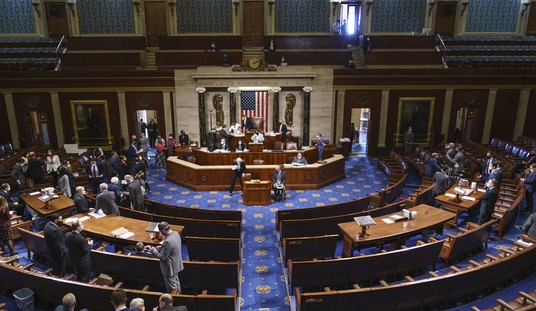Steven Mufson, writing in the Washington Post, noted that long before the Solyndra debacle, Washington had been in the habit of playing venture capitalist in the energy industry. It had failed in nearly every case. He cites the Clinch River Breeder reactor, synthetic fuel corporations, the hydrogen-powered car and clean coal — projects spanning both Republican and Democratic administrations. “Not a single one of these much-ballyhooed initiatives is producing or saving a drop or a watt or a whiff of energy, but they have managed to burn through far more more taxpayer money than the ill-fated Solyndra.”
Mufson may have spoken too soon. The Sons of Solyndra are still catching up. CBS News reports that there may be 11 more Solyndra-like catastrophes out there — ‘Green Energy’ projects sponsored by the Obama administration. Five have already filed for bankruptcy.
But the most important news is buried in the lede. It isn’t that there are deadly contact mines in the water. The real headlines are that the President is still saying, “damn the Solyndras, full speed ahead!” Why? Because everybody knows that Green Energy is good and therefore if one persists for long enough, even failures can become successes.
Watch the CBS video report here.
Some forgotten military wag said in an era long before quotes were attributed that “one should never reinforce failure because failure reinforces itself.” Everyone has heard it. Everyone that is, but Energy Secretary Steven Chu. Mufson describes how Chu regards the problem:
Despite this track record and the recent Solyndra failure, Energy Secretary Chu remains undeterred. Citing examples from Civil War-era railroads to airplanes to semiconductors, he has defended government’s role in funding new technologies and promising companies.
“Americans have always led by looking ahead. Even in the midst of the Civil War, when our country was under incredible stress, we planned for the future,” Chu said in September. “President Lincoln signed the Pacific Railway Act of 1862, which authorized generous public financing for two private companies — Union Pacific Railroad Company and Central Pacific Railroad Company — to lower the investor risk in building railroads in unsettled territories. In 1869, the first Transcontinental Railroad was completed at Promontory Summit, Utah, revolutionizing transport in this country and opening up a world of possibilities for industry.”
The basic argument is that only government can afford to keep repeating mistakes if the process leads to eventual breakthroughs. But Stanford University professor Richard White, a historian of the American West who wrote “Railroaded: The Transcontinentals and the Making of Modern America” points out the basic problem: the view doesn’t coincide with the actual facts.
“I admire Steven Chu a great deal, but his knowledge of the Pacific Railway Act unfortunately appears to be about equal to my knowledge of high-energy physics,” White said in an interview. He said the legislation produced a disaster far larger than the lifeless factory that Solyndra has left behind.
White said that Union Pacific and Central Pacific became two of the most hated corporations in the West, spawning political opposition wherever they went. Within 10 years of giving them land grants and loan guarantees, the federal government reversed its policy and eventually sued to recover its investment. The litigation dragged on into the 20th century.
Surely it is fair to ask why is government is so poor at picking winners or losers — or as others would put it — making investments for the future. One possible reason is that they are investing other people’s money and act differently from those who are putting their own necks on the line.
The other reason is politics. Daniel Kahneman, in his book Thinking, Fast and Slow recalls Danny Kaye’s line that some people’s favorite sport is “jumping to conclusions”. When Kahneman speaks of factors like “the neglect of ambiguity and the suppression of doubt”, “a bias to believe and confirm” and perhaps most relevantly, “the halo effect”, he is talking about a political process.
You meet a woman named Joan at a party and find her personable and easy to talk to. Now her name comes up as someone who could be asked to contribute to a charity. What do you know about Joan’s generosity? The correct answer is that you know virtually nothing, because there is little reason to believe that people who are agreeable in social situations are also generous contributors to charities. But you like Joan and you will retrieve the feeling of liking her when you think of her. You also like generosity and generous people. By association, you are now predisposed to believe that Joan is generous. And now that you believe she is generous, you probably like Joan even better than you did earlier, because you have added generosity to her pleasant attributes. Real evidence of generosity is missing in the story of Joan, and the gap is filled by a guess that fits one’s emotional response to her. In other situations, evidence accumulates gradually and the interpretation is shaped by the emotion attached to the first impression.
Kahneman, Daniel (2011-11-03). Thinking, Fast and Slow (p. 82). Penguin UK. Kindle Edition.
Thus people who are politically allied to the President are unlikely to see the situation for what it is, especially if they work for him. Chu in the last analysis, can never say the President is all wet. And as for the President, the money he’s throwing at the Solyndras isn’t his anyway — and he’s giving it to his supporters to boot. The incentives could not be more perverse.
This is a radically different situation from one in which the investor is the steward of his own money, or who works for people investing their money. Then the entire focus is to find a heuristic that leads to success; if there isn’t one the incentive is to recognize categorical failure as soon as it becomes clear and stop the loss, because it’s your money that you are losing.
Where better to look a the future of a politically driven system than Europe, where President Obama himself looks for inspiration. Andrew McKillop, a former energy policy expert at the European Commission, writes that ‘Green Energy’ across Europe is unsustainable. It is “free-wheeling to disaster”, creating higher energy costs, power shortages and ever-increasing government subsidies. As a result, political support for it is declining, though few have yet been so bold as to openly bolt from the ranks.
Current goals and strategies are in most cases neither sustainable nor rational, as shown by growing political criticism and the loss of broad support amongst the public for what are perceived as expensive and unnecessary, irrational or perverse goals and strategies …
Presently we have a lose-lose context for all players except financial, and for them and as ever, this is short term gain only. Overall costs for achieving any specific level of green energy development are massively raised by this lose-lose context, which can only drive a general loss of credibility for green energy. One thing is sure: the present outlook for green energy transition in Europe is not sustainable and will change.
Perhaps even the President sees it coming, hopes the crash won’t affect him politically. It was reported that administration knew in advance that Solyndra was doomed but exerted pressure on the company to keep going until the 2010 elections had passed, the better not to shake the faith of the true believers. In the end it was all about ‘optics’ and not at all about sunlight.
How to Publish on Amazon’s Kindle for $2.99
The Three Conjectures at Amazon Kindle for $1.99
Storming the Castle at Amazon Kindle for $3.99










Join the conversation as a VIP Member